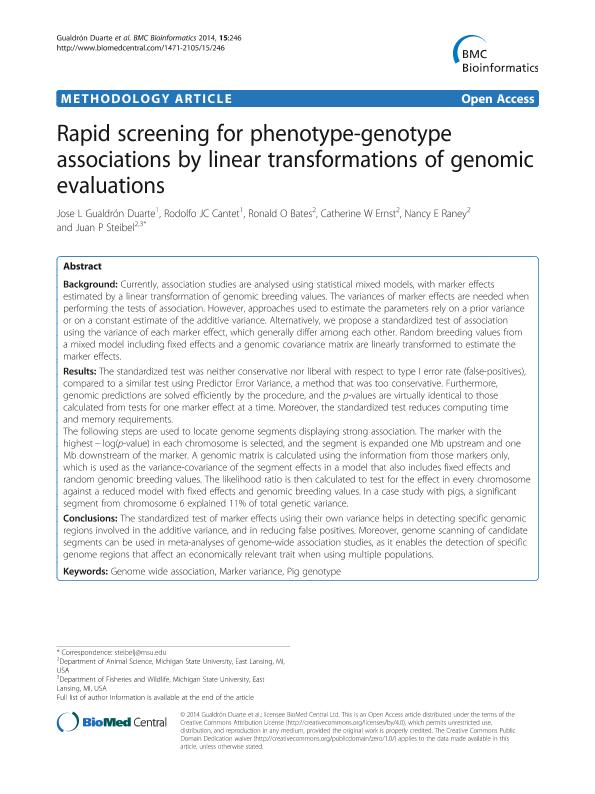Mostrar el registro sencillo del ítem
dc.contributor.author
Gualdron Duarte, Jose Luis

dc.contributor.author
Cantet, Rodolfo Juan Carlos

dc.contributor.author
Bates, Ronald O.
dc.contributor.author
Ernst, Catherine W.
dc.contributor.author
Raney, Nancy E.
dc.contributor.author
Steibel, Juan P.
dc.date.available
2017-05-11T18:31:35Z
dc.date.issued
2014-07
dc.identifier.citation
Gualdron Duarte, Jose Luis; Cantet, Rodolfo Juan Carlos; Bates, Ronald O.; Ernst, Catherine W.; Raney, Nancy E.; et al.; Rapid screening for phenotype-genotype associations by linear transformations of genomic evaluations; Biomed Central; Bmc Bioinformatics; 15; 7-2014; 246-256
dc.identifier.issn
1471-2105
dc.identifier.uri
http://hdl.handle.net/11336/16317
dc.description.abstract
Background: Currently, association studies are analysed using statistical mixed models, with marker effects estimated by a linear transformation of genomic breeding values. The variances of marker effects are needed when performing the tests of association. However, approaches used to estimate the parameters rely on a prior variance or on a constant estimate of the additive variance. Alternatively, we propose a standardized test of association using the variance of each marker effect, which generally differ among each other. Random breeding values from a mixed model including fixed effects and a genomic covariance matrix are linearly transformed to estimate the marker effects. Results: The standardized test was neither conservative nor liberal with respect to type I error rate (false-positives), compared to a similar test using Predictor Error Variance, a method that was too conservative. Furthermore, genomic predictions are solved efficiently by the procedure, and the p-values are virtually identical to those calculated from tests for one marker effect at a time. Moreover, the standardized test reduces computing time and memory requirements. The following steps are used to locate genome segments displaying strong association. The marker with the highest − log(p-value) in each chromosome is selected, and the segment is expanded one Mb upstream and one Mb downstream of the marker. A genomic matrix is calculated using the information from those markers only, which is used as the variance-covariance of the segment effects in a model that also includes fixed effects and random genomic breeding values. The likelihood ratio is then calculated to test for the effect in every chromosome against a reduced model with fixed effects and genomic breeding values. In a case study with pigs, a significant segment from chromosome 6 explained 11% of total genetic variance. Conclusions: The standardized test of marker effects using their own variance helps in detecting specific genomic regions involved in the additive variance, and in reducing false positives. Moreover, genome scanning of candidate segments can be used in meta-analyses of genome-wide association studies, as it enables the detection of specific genome regions that affect an economically relevant trait when using multiple populations.
dc.format
application/pdf
dc.language.iso
eng
dc.publisher
Biomed Central

dc.rights
info:eu-repo/semantics/openAccess
dc.rights.uri
https://creativecommons.org/licenses/by-nc-sa/2.5/ar/
dc.subject
Genome Wide Association
dc.subject
Marker Variance
dc.subject
Pig Genotype
dc.subject.classification
Otras Producción Animal y Lechería

dc.subject.classification
Producción Animal y Lechería

dc.subject.classification
CIENCIAS AGRÍCOLAS

dc.title
Rapid screening for phenotype-genotype associations by linear transformations of genomic evaluations
dc.type
info:eu-repo/semantics/article
dc.type
info:ar-repo/semantics/artículo
dc.type
info:eu-repo/semantics/publishedVersion
dc.date.updated
2017-04-25T13:28:14Z
dc.journal.volume
15
dc.journal.pagination
246-256
dc.journal.pais
Reino Unido

dc.journal.ciudad
Londres
dc.description.fil
Fil: Gualdron Duarte, Jose Luis. Universidad de Buenos Aires. Facultad de Agronomia. Departamento de Producción Animal; Argentina. Consejo Nacional de Investigaciones Científicas y Técnicas; Argentina
dc.description.fil
Fil: Cantet, Rodolfo Juan Carlos. Universidad de Buenos Aires. Facultad de Agronomia. Departamento de Producción Animal; Argentina. Consejo Nacional de Investigaciones Científicas y Técnicas; Argentina
dc.description.fil
Fil: Bates, Ronald O.. Michigan State University; Estados Unidos
dc.description.fil
Fil: Ernst, Catherine W.. Michigan State University; Estados Unidos
dc.description.fil
Fil: Raney, Nancy E.. Michigan State University; Estados Unidos
dc.description.fil
Fil: Steibel, Juan P.. Michigan State University; Estados Unidos
dc.journal.title
Bmc Bioinformatics

dc.relation.alternativeid
info:eu-repo/semantics/altIdentifier/doi/http://dx.doi.org/10.1186/1471-2105-15-246
dc.relation.alternativeid
info:eu-repo/semantics/altIdentifier/url/https://bmcbioinformatics.biomedcentral.com/articles/10.1186/1471-2105-15-246
dc.relation.alternativeid
info:eu-repo/semantics/altIdentifier/url/https://www.ncbi.nlm.nih.gov/pmc/articles/PMC4112210/
Archivos asociados
